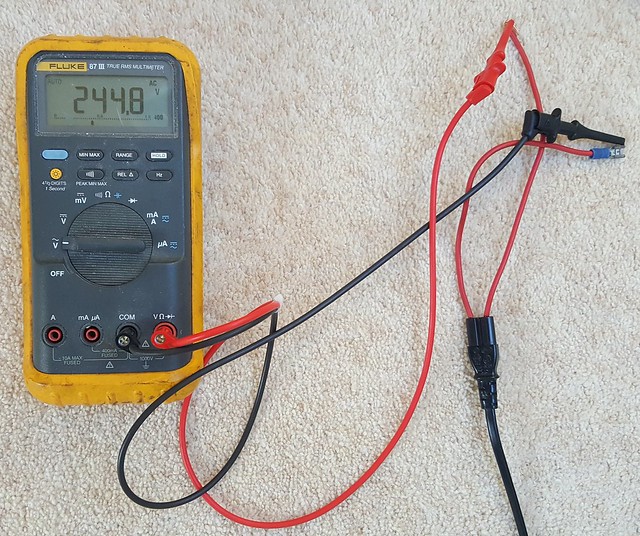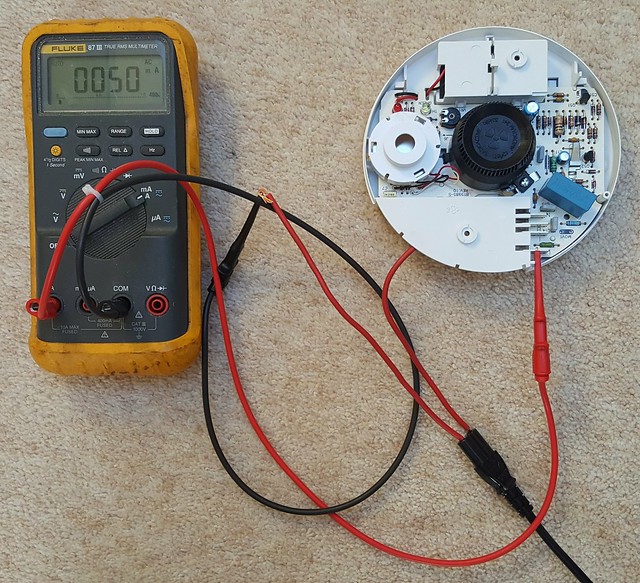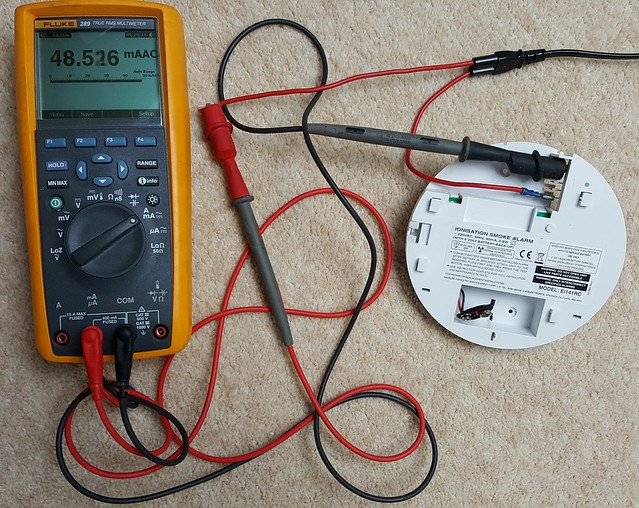17 Watts for each smoke alarm!
Discussion
Hi All
I have been looking at ways of controlling my electricity base load at home and got myself an energy monitor.
After finding a base load of over 250watts I did some digging and found 3 culprits:
So googling does not seem to show the power consumption for quoted "Energy Saving" replacements.
Can anybody recommend any mains alarms which have stated power consumptions?
Many thanks!
I have been looking at ways of controlling my electricity base load at home and got myself an energy monitor.
After finding a base load of over 250watts I did some digging and found 3 culprits:
- My printer was drawing 50watts in idle mode
- My Surround amp was drawing another 50 watts in idle mode.
- My 10 mains smoke alarms installed as part of a loft conversion are drawing 17 watts each all the time!
So googling does not seem to show the power consumption for quoted "Energy Saving" replacements.
Can anybody recommend any mains alarms which have stated power consumptions?
Many thanks!
My base load has crept up to 960w ! Did a power down the other day and there were no real savings to be had anywhere.
I did get some plugin z-wave modules to power down the sky boxes (~25w) overnight, but i stopped using them as I was concerned that i would kill the power supply over time.
I run aico interlinked mains smoke alarms, just tested them (have an inline wattmeter) and the current draw is too low to measure
I did get some plugin z-wave modules to power down the sky boxes (~25w) overnight, but i stopped using them as I was concerned that i would kill the power supply over time.
I run aico interlinked mains smoke alarms, just tested them (have an inline wattmeter) and the current draw is too low to measure
Edited by eliot on Saturday 20th May 10:59
Spunagain said:
*My 10 mains smoke alarms installed as part of a loft conversion are drawing 17 watts each all the time!
Can anybody recommend any mains alarms which have stated power consumptions?
That seems very high... Presumably, they're battery-backed - probably with a 9v PP3?Can anybody recommend any mains alarms which have stated power consumptions?
We've got a mains smoke alarm that isn't currently mains-connected (I really must fish about through the hole and find where the cable is before I lose the connector again). I think I recharge the PP3 once a year or so when it starts the low-battery bleeping...
If you put a fresh PP3 in, and disconnect the mains connector, how long does the battery last?
They are AICO LTD Ei141RC which is a radio linked system, and has a pp3 battery back up. The "back-up" batteries seem to only last a year or two which seems to be less than the battery only alarms used to have!
Google suggests they are very popular!
The label claims 0.8W but this is clearly wrong.
I have disconnected a load of the and the power drops on the energy monitor by 17 watts for each one!
The monitor is a new Owl and seems pretty accurate based on measurement of lights as they come on and off.
The muppets that did the loft mucked up so many things that I would not be supprised if they are fake Chinese knock offs.
Google suggests they are very popular!
The label claims 0.8W but this is clearly wrong.
I have disconnected a load of the and the power drops on the energy monitor by 17 watts for each one!
The monitor is a new Owl and seems pretty accurate based on measurement of lights as they come on and off.
The muppets that did the loft mucked up so many things that I would not be supprised if they are fake Chinese knock offs.
Spunagain said:
They are AICO LTD Ei141RC which is a radio linked system, and has a pp3 battery back up. The "back-up" batteries seem to only last a year or two which seems to be less than the battery only alarms used to have!
Google suggests they are very popular!
The label claims 0.8W but this is clearly wrong.
I have disconnected a load of the and the power drops on the energy monitor by 17 watts for each one!
The monitor is a new Owl and seems pretty accurate based on measurement of lights as they come on and off.
The muppets that did the loft mucked up so many things that I would not be supprised if they are fake Chinese knock offs.
The 140 series wont have radiolink built in - youll have an interlink cable or the bulkier bases that contain the radiolink circuits. You can slot the 160 series onto the same bases which have rechargabe lithium batteries but cost £10~ more hence the popularity of the 9v model, despite the idiocy of fitting a mains alarm you have to keep changing batts on.Google suggests they are very popular!
The label claims 0.8W but this is clearly wrong.
I have disconnected a load of the and the power drops on the energy monitor by 17 watts for each one!
The monitor is a new Owl and seems pretty accurate based on measurement of lights as they come on and off.
The muppets that did the loft mucked up so many things that I would not be supprised if they are fake Chinese knock offs.
Hi Hairyben
You are right! I have had a quick look under the "Easifit base" and there is at least one extra wire - there are brown, black, grey and earth one of which I guess is the signal wire. I was thrown by the web page which said Radiolink compatible, not realising you have to fit different bases.
It does not explain the excessive load on each of the detectors unless they are either fake, all from a faulty batch or the 0.8W spec on the label is let's say "optimistic".
You are right! I have had a quick look under the "Easifit base" and there is at least one extra wire - there are brown, black, grey and earth one of which I guess is the signal wire. I was thrown by the web page which said Radiolink compatible, not realising you have to fit different bases.
It does not explain the excessive load on each of the detectors unless they are either fake, all from a faulty batch or the 0.8W spec on the label is let's say "optimistic".
Spunagain said:
Hi Hairyben
You are right! I have had a quick look under the "Easifit base" and there is at least one extra wire - there are brown, black, grey and earth one of which I guess is the signal wire. I was thrown by the web page which said Radiolink compatible, not realising you have to fit different bases.
It does not explain the excessive load on each of the detectors unless they are either fake, all from a faulty batch or the 0.8W spec on the label is let's say "optimistic".
Same ones as I use. Grey wire is the comms link. All my critical loads like these are on a dedicated subpanel which has its own watt meter - i cant see any difference in consumption when i pull the breaker (5 devices). You are right! I have had a quick look under the "Easifit base" and there is at least one extra wire - there are brown, black, grey and earth one of which I guess is the signal wire. I was thrown by the web page which said Radiolink compatible, not realising you have to fit different bases.
It does not explain the excessive load on each of the detectors unless they are either fake, all from a faulty batch or the 0.8W spec on the label is let's say "optimistic".
eliot said:
Same ones as I use. Grey wire is the comms link. All my critical loads like these are on a dedicated subpanel which has its own watt meter - i cant see any difference in consumption when i pull the breaker (5 devices).
Technically it should be black as "secondary live" but a lot of people dont realise this and still like to associate black as neutral. Regardless it could be either so OP check your own first if fiddling around as muddling them can damage aico alarms.
lost in espace said:
Mine are 9W
Thanks! Is that measured or on the label?Peeking inside the detector it is all very analogue. The power supply look like it uses a big series capacitor to drop the mains voltage and the rectify it to give a DC supply. I am not sure how efficient these are but where they could be consuming the stated 0.8 watt, they may show a much higher VA (Volt-Ampere) due to a very bad power factor, which may be confusing the energy meter sensor.
eliot said:
Same ones as I use. Grey wire is the comms link. All my critical loads like these are on a dedicated subpanel which has its own watt meter - i cant see any difference in consumption when i pull the breaker (5 devices).
Thanks eliot. Very sensible! My installers however have put the 2 kitchen ones on a dedicated breaker, the rest of the ground floor ones on the ground floor socket breaker and 1st floor ones on the 1st floor lighting circuit. Which is a little worrying if the sense line becomes live. (Have I mentioned they were muppets?)I think this means I need to isolate all three circuits to safely work on any one of them.
I am not sure if damage can be caused if some alarms are live while some are powered down?
hairyben said:
Regardless it could be either so OP check your own first if fiddling around as muddling them can damage aico alarms.
I think my next steps are1) Borrow a decent calibrated Fluke Ammeter from work and measure the actual current into and voltage across a couple of the sensors. Armed with that I can see if they are really consuming that much and if so I can reach out to Aico and see what they propose.
2) To check all the alarm bases are wired together correctly
Thanks all for your help steering me in the right direction, I will report back when I have some new measurement.
You really shouldn't have a "bridge" between different outgoing circuits.
What you can (and could) have with aico is a mixture of hardwired interlinks and radiolink bridges, for example you could have 3 hardwired together, only one of which has radiolink, then others with radiolink and all alarsm on the system can "see" each other.
What you can (and could) have with aico is a mixture of hardwired interlinks and radiolink bridges, for example you could have 3 hardwired together, only one of which has radiolink, then others with radiolink and all alarsm on the system can "see" each other.
I am working from memory so could be wrong but I am pretty sure the interlink signal on aico alarms is pretty low voltage, maybe around 9V? So I don't think there is much safety risk from running them from different circuits. Don't rely on this info without checking first though, especially as, if there is an interlink connecting two circuits there could be a live and neutral connecting them too!!
EDIT: just to be clear, I am not advocating linking from different circuits, I just wouldn't panic if I saw some that were.
Also, it is an arguable point whether alarms should be on a separate circuit. They have battery backup so there is no safety risk if they are on a lighting circuit and that circuit is tripped. In fact having them on a separate circuit makes it a bit too easy for the user to just turn them off if there are too many nuisance alarms. If they are on a lighting circuit that is much less likely to happen. It is pretty unlikely someone will have a light circuit off for long enough to flatten the backup battery.......
As to the power use, if the really are taking 17W I would talk to Aico (their support is very good in my experience) because that really does not sound right. (not that I have ever tested one....)
EDIT: just to be clear, I am not advocating linking from different circuits, I just wouldn't panic if I saw some that were.
Also, it is an arguable point whether alarms should be on a separate circuit. They have battery backup so there is no safety risk if they are on a lighting circuit and that circuit is tripped. In fact having them on a separate circuit makes it a bit too easy for the user to just turn them off if there are too many nuisance alarms. If they are on a lighting circuit that is much less likely to happen. It is pretty unlikely someone will have a light circuit off for long enough to flatten the backup battery.......
As to the power use, if the really are taking 17W I would talk to Aico (their support is very good in my experience) because that really does not sound right. (not that I have ever tested one....)
eliot said:
I believe they are supposed to a single circuit fed by a dedicated rcbo in the consumer (mine certainly are).
Then they still get power when the main rcd trips for whatever reason.
School of thought being pushed on that today is that they're better powered off a lighting circuit to a) prevent silly people either deciding to switch the circuit off and b) that if the cirucit fails you're more likely to notice promptly.Then they still get power when the main rcd trips for whatever reason.
hairyben said:
School of thought being pushed on that today is that they're better powered off a lighting circuit to a) prevent silly people either deciding to switch the circuit off and b) that if the cirucit fails you're more likely to notice promptly.
excellent, it is not just me that thinks that then 
brman said:
I am working from memory so could be wrong but I am pretty sure the interlink signal on aico alarms is pretty low voltage, maybe around 9V? So I don't think there is much safety risk from running them from different circuits. Don't rely on this info without checking first though, especially as, if there is an interlink connecting two circuits there could be a live and neutral connecting them too!!
EDIT: just to be clear, I am not advocating linking from different circuits, I just wouldn't panic if I saw some that were.
Ive a vaugue memory of seeing it done on an install that resulted in insulation resistance fails. Think maybe aico connects the interlink to neutral on the hardwired remote locate (silence all except triggering alarm) button? Could be an issue if circuits are on different rcds.EDIT: just to be clear, I am not advocating linking from different circuits, I just wouldn't panic if I saw some that were.
Well a bit of faffing and borrowing a couple of meters I am getting 245V at the mains:

And I measured the current with a couple of different meters and I get:

or

Taking the lower one. P = I x V = 0.048 Amps x 244.8 Volts = 11.8Watts!
You can see on the photo on the meter label it actually says 230V, 40mA, 0.8W which does not make sense! 230 Volts x 0.8 Amps is 9.2 Watts.
A call to Aico in the morning I think!
I also noticed the Voltage in the loft dropped to 238.9V when I plugged the Tesla into the 7kw charger!
Edited to add - please do not try this at home unless you know what you are doing. Mains electricity is very nasty. I connected up with the plug out, plugged in, switched on, took photo, unplugged. I did not touch anything while it was live.

And I measured the current with a couple of different meters and I get:

or

Taking the lower one. P = I x V = 0.048 Amps x 244.8 Volts = 11.8Watts!
You can see on the photo on the meter label it actually says 230V, 40mA, 0.8W which does not make sense! 230 Volts x 0.8 Amps is 9.2 Watts.
A call to Aico in the morning I think!
I also noticed the Voltage in the loft dropped to 238.9V when I plugged the Tesla into the 7kw charger!
Edited to add - please do not try this at home unless you know what you are doing. Mains electricity is very nasty. I connected up with the plug out, plugged in, switched on, took photo, unplugged. I did not touch anything while it was live.
Edited by Spunagain on Thursday 1st June 09:11
Gassing Station | Homes, Gardens and DIY | Top of Page | What's New | My Stuff



